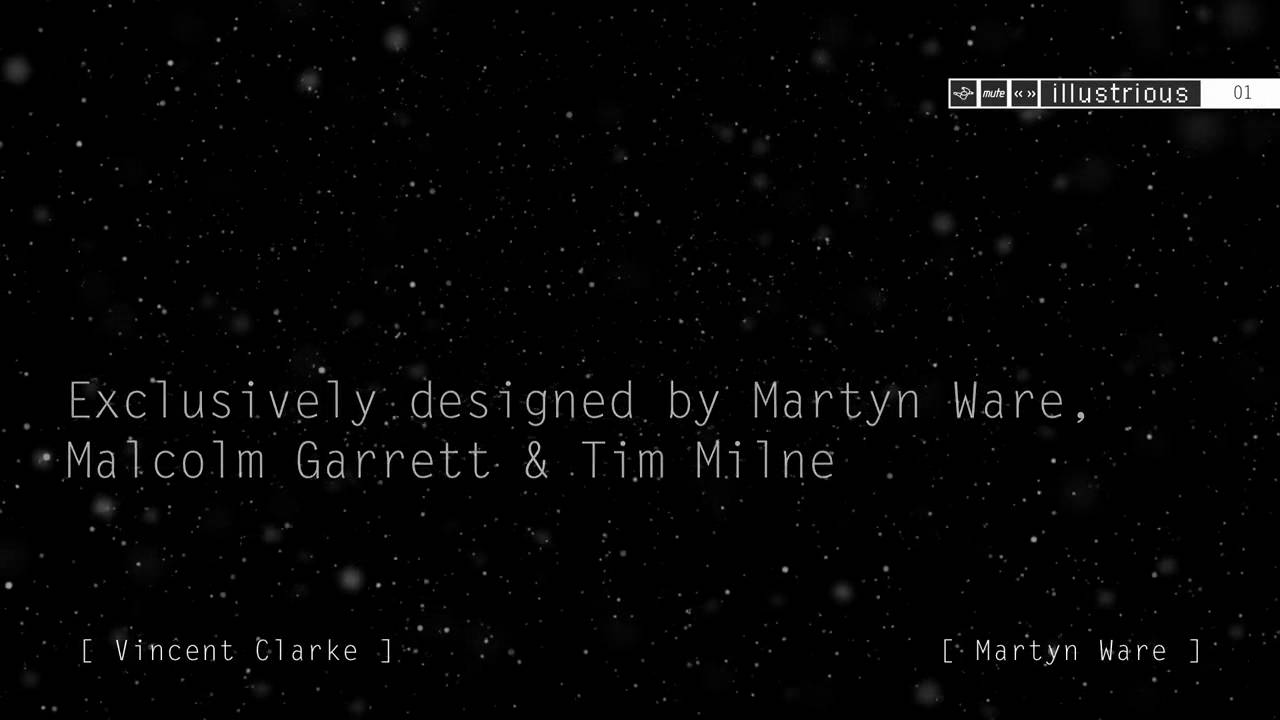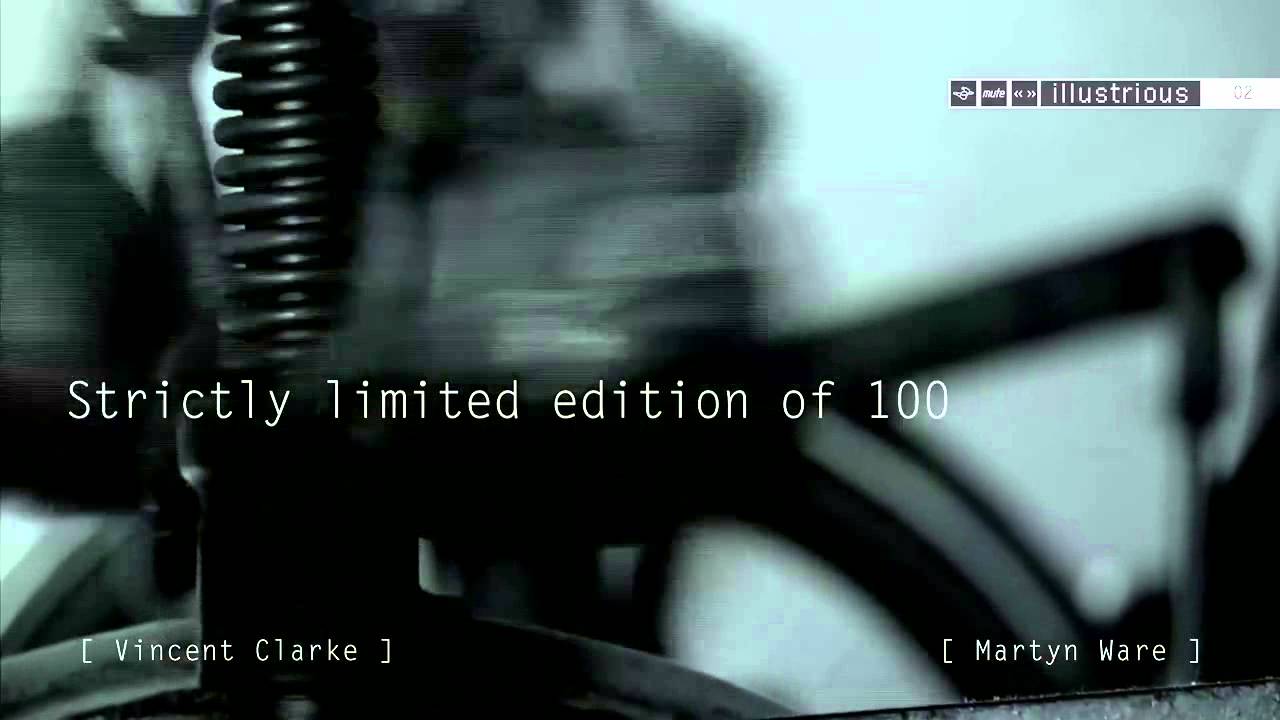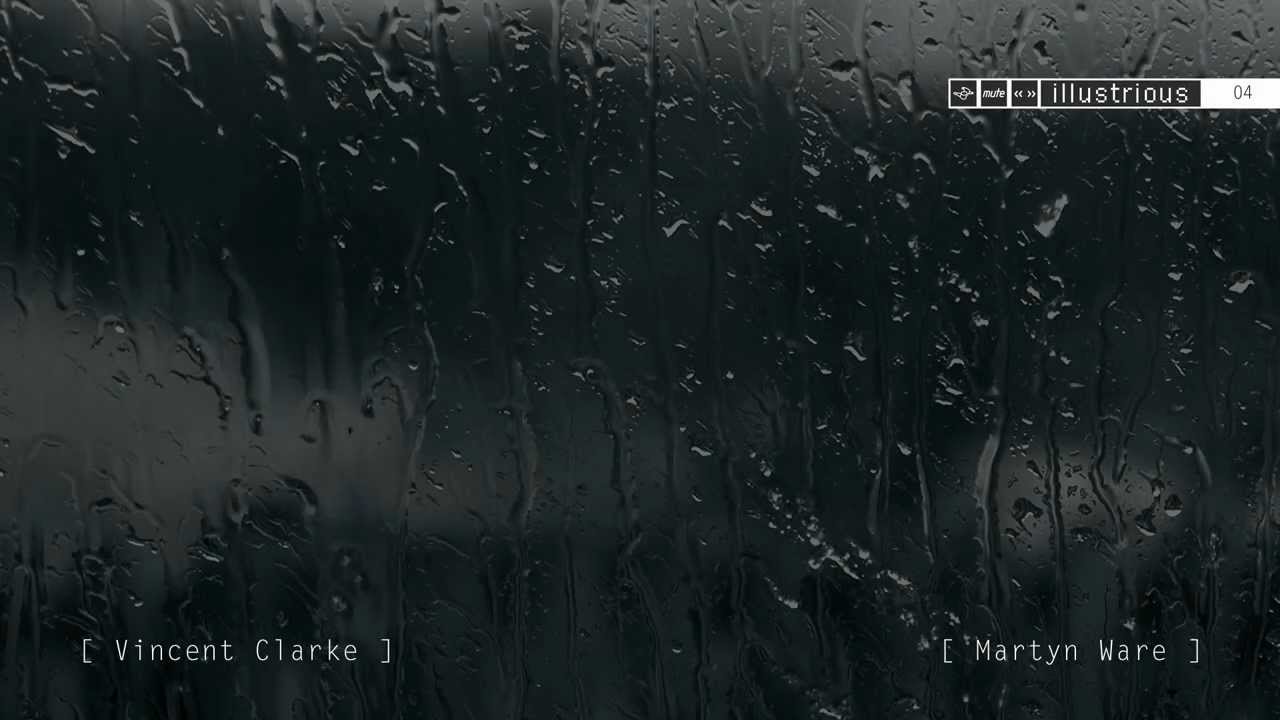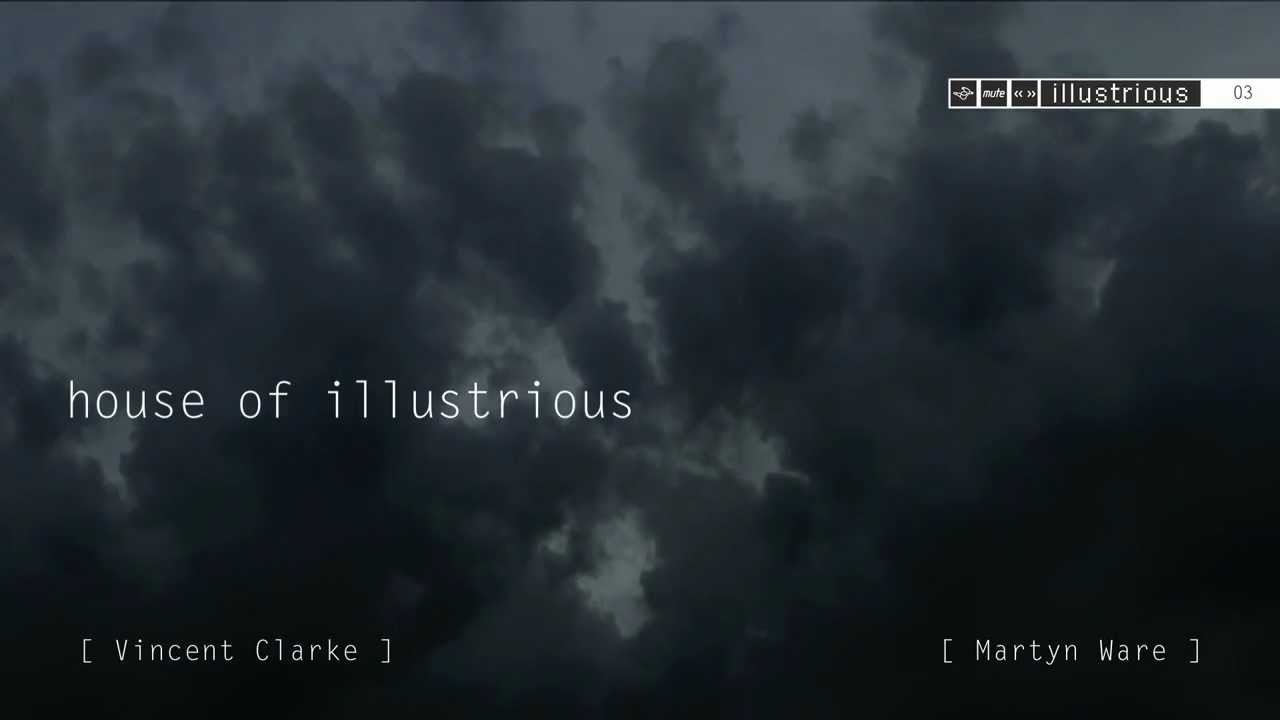The House Of Illustrious box set is as luxurious as the name suggests. It is a piece of dense, high quality foam etched with a laser so that it houses ten CDs, which cover much (but nowhere near all) of the joint recorded work of Vince Clarke of Erasure and Martyn Ware of Heaven 17. It is obviously made with one eye on the luxury CD box set market, but then the packaging and design suit the high concept music to a tee. Certainly there isn’t the conceptual/financial dissonance you might experience when looking at high end luxury box sets of music by Moondog, Robert Johnson or The Television Personalities. Even the cellophane wrapping is meant to remind the purchaser of an expensive bottle of perfume rather than simply a bunch of discs from Fopp.
Originally the music was going to be sealed inside the box. This design would have left the purchaser with a choice to make: smash the packaging or do not access the discs (it was to come complete with download token for the collectors with one eye on posterity and an aversion to hammers). Another idea was to have the music contained in a tiny package but one that was also incredibly beautiful, as if this very small, digital objet d’art were encapsulating the idea of a very small diamond, except instead of a gemstone it would be the most miniscule, most beautiful USB stick imaginable encrusted with crystals. Another idea was to have the ten CDs housed on weighty hockey puck like discs which would, in turn, be attached to a heavy brushed steel spindle which was made in Sheffield. It was going to be so beautifully manufactured that the CDs would spin around in the case without the top and bottom of the spindle being removed, reflecting the analogue synth button and switch fetish that both Martyn Ware and Vince Clarke possess, as well as the former’s Sheffield birthplace.
This level of conceptual ingenuity, married to an emphasis on craft and trade being the equal to ideas of art, speaks volumes about this collaboration which is now nearly 15 years old. Ware, who first cut his teeth in The Future before forming The Human League, first met Clarke, one of the founding members of Depeche Mode, when he was drafted in by Mute to produce an Erasure album. The pair have remained in constant contact since, working on a dizzying array of music together. They released two albums on Mute, Pretentious (1999) and Spectrum Pursuit Vehicle (2001), which are both included in the box set along with another eight albums’ worth of music culled from various artistic and commercial projects, mixed with state of the art 3D soundscaping software that the pair had a hand in getting developed.
The music itself covers so much ground that it is almost unfair to give it the ambient label that some have, ranging as it does from musique concrète sound collage to lush pastoral electronica via moody ambient techno, neo-classical minimalism and heavily processed field recordings. The duo between them are responsible for some of The Quietus’ favourite ever recorded music so it was a pleasure to catch up with both of them.
How did you meet?
Martyn Ware: I was always an admirer of Erasure. Not all of the music but the vast majority of what they did. And I was an admirer of Vince’s work in general. Mute were looking for a producer for the album which turned out to be I Say, I Say, I Say and Daniel [Miller] asked me to do it. We got on like a house on fire. I’m a big admirer of Daniel’s work, Mute represents capitalism with a socialist’s conscience and he has great taste in music. Vince and I are like two peas in a pod, albeit one pea from Basildon and the other from Sheffield. And Andy [Bell] as well. We’ve all become very good friends. The album did really well and Heaven 17 went on tour with Erasure, which was really the start of our live career as we didn’t really play live before that.
In the early days of synth pop in the UK the field was very narrow. Were you fans of The Human League or did you see them as the competition?
Vince Clark: I was a huge fan. A huge fan. The first two albums? [pause] I think most of the time I initially spent with Martyn recording, I was asking him how he did this and how he did that on those first two albums. I was completely in awe.
I’m guessing the 3D sound sculpting software you used on the Illustrious project has started to trickle down into the mainstream of sound engineering since the start of the Experiment. Can you explain to me how this software works?
MW: I’d been interested in Surround Sound, Ambisonics, Holophonics and 3D soundscaping for some time. The one thing that I didn’t like about any of the software was that they were designed for use by acoustic designers and theoreticians. So a lot of it was very dense and was about inputting a lot of figures. I thought it would be nice to create something of this ilk which would be very easy to use and very easy to teach to musicians. And the key part of why it works is that you can see where the sounds are meant to be in three dimensions. For example, the space we use to work in, situated in Brixton, is an octagonal room with a ring of speakers high up and a ring of speakers low down, so we can move up to 16 sounds round the room simultaneously. And of course that’s a very complex thing to do if you’re just relying on your ears. So the idea was to get a piece of visualisation software that allowed you to move the sounds round the room like audio air traffic control. And this is the software that we still use now.
The first project you undertook, in 1999, was Music For Multiple Dimensions, later released as the album Pretentious, featured in full here, which was commissioned by the then new National Centre For Popular Music in Sheffield. What came first, the group or the commission?
VC: Martyn approached me and said, ‘There’s this exhibition which is opening in Sheffield and they want to have an exhibition there with sound’, and would I be interested in working on it, and that was the start of the whole [collaboration].
MW: In 1997, 1998 we were doing various things together for adverts and small films and we were enjoying working together. And then I was contacted by the people running the National Centre For Popular Music, a new museum in Sheffield, to see if I’d be interested in being an advocate and endorsing it and I said, ‘Yeah, as long as I can get involved creatively.’
They said that they wanted to install a 3D sound auditorium in the museum, but we don’t really know what to do with it. So I acted as unpaid consultant on that. But they ended up commissioning some software to our specification. It’s now called 3D AudioScape, which we used on Illustrious and have done for over ten years. Of course the National Centre For Popular Music in Sheffield was a bit of a flop. Our part was by far and away the best aspect of it. It closed down after a year, but we still had access to the software.
I know you can call Martyn an ideas guy or conceptualist but other than that, how is the labour usually divided?
VC: The way that it usually works is Martyn does the lunches… [laughs] and then he comes to me and says, “We’ve got this piece of work to do.” He’ll give me a few starting points, saying make it sound a bit like this or a bit like that, and I’ll start the rough work of programming some things. And once I’ve got the rough soundscapes, then Martyn will mix it and make it sound really cool. Martyn’s a fantastic mixing guy, he really knows that side of the process.
Do you think of what you do together as being ambient?
VC: When we first started doing the Clarke and Ware Experiment it was a radical departure for me. It was certainly very different at the time. I mean, Andy [Bell] and I started doing an album called Erasure which was much more of an ambient album but with songs on as well, but it was only really with Martyn when we did Illustrious that I really started listening to ambient music. I don’t know… everybody hates labels. For me, music is something that has to move you in some way or other, whether that’s lyrically or the way that chords progress or the way that a key changes, but with a lot of the stuff we do, they’re long pieces and very, very repetitive but then there will be a key change or chord change and that acts almost as like a release and I think that for me is the best part of ambient music… or whatever you want to call it.
MW: In 1979 The Human League put out an EP or mini album called The Dignity Of Labour and as far as I’m concerned that’s where the lineage comes from and our work as The Future. A lot of our work [in the 1970s] was impressionistic, non-linear and ambient. A lot of the stuff Vince and I did was getting back to basics, as far as I was concerned. I don’t think it came out of the blue.
What happened after the Sheffield commission?
MW: We had the one 15 minute piece and we thought, ‘This is ridiculous. We might as well do an album’s worth and see if Daniel [Miller] will put it out as an album, and that became Pretentious.
Certainly the album Pretentious doesn’t fit the popular perception of whale song, new age, flotation tank, ambient music, does it?
VC: No, but that was almost like a demo record… demonstrating how the 3D AudioScape software could work.
What got the ball rolling properly?
MW: Then we were commissioned to do an ambient piece by an advertising company called Leonardo. Our suggestion was to create a piece that linked colour and sound. We dressed the underground space of the Roundhouse; this was before it was reopened and it was still in a state of disarray. We decided we wanted it to be white and I got a lighting designer friend, Pip Rhodes, to create a slowly changing colour field, which would go through the colour spectrum over the two hour duration of the music. And we designed the music to match the colour change as part of a synaesthetic experiment and that’s what became Spectrum Pursuit Vehicle and that album came out on Mute as well. By this time Illustrious had started to get noticed and we started to get a lot of commercial and artistic commissions. And what we do ranges from the very musical, such as Spectrum Pursuit Vehicle to the more found sound and impressionistic stuff like Shine.
What about the musique concrete, found sound, field recording aspect of it?
VC: That’s more Martyn’s thing than mine.
MW: Shine established the methodology for us which enabled us to explain to people what we wanted to achieve when people came to us with a brief. It allowed us to say, this is our expertise, this is what we do. We do some deep research, we normally engage researchers attached to the subject, we do some deep research regarding the sound recordings based on the research and we assemble things together and see if we can create a three dimensional picture in the listener’s mind’s eye of what we’re trying to achieve.
Shine must have a special place in your heart given your history in Sheffield, Martyn. Can you tell me a bit more about the sounds that make up that piece?
MW: We were commissioned by the Millennium Galleries in Sheffield to make a piece for their Metal Work Gallery. The first thing we did was put together a schedule of people we’d like to talk to in different manufacturing environments in Sheffield because, as anyone with any interest in the story of British manufacturing knows, our city has an incredible story.
At one time there were a couple of hundred thousand people working in the steel industry. And then during Thatcher’s pogrom she managed to halve that and then it’s declined ever since. And it wasn’t just the large steel mills that were closing but it was the smaller, craft based engineers who were suffering as well. They used to be called Little Mesters. People who would have their own little workshops and do highly skilled finishing work and sometimes even manufacturing as well. We met one guy who produced hand-made penknives from an ingot to completion, including bone handle in 40 minutes. I asked him how many he could make a week and he said about 30. I said, “God, they must be so expensive to buy. Really incredibly well made and beautiful…” And he said, “Yeah, you’re right, I sell them for £12.” He’s being ripped off…
Anyway, we were determined to capture this dying soundscape of Sheffield because it’s what we grew up with. I’ve told you before about lying in bed on a Summer’s night hearing the enormous, muffled booms of the drop forges, drifting along across the still air and how it would send me to sleep, because it sounded like a heartbeat. I wasn’t really conscious of thinking of it in those terms then but subconsciously I’m sure it influenced the type of music we’d go on to make.
We did a lot of research, did a lot of recording. So we were shown round a lot of factories, some of which were still doing drop forge work. We saw silver smithing, grinding and milling. The milling was extremely poignant for me because this is what my father spent 60 years of his life doing and probably ending up dying early because of the inhalation of metal dust. And all of these amazing stories about a dying industry. I thought it was my duty that if I was going to get access to it – as one of the last people to get access to it all probably – to tell this story well.
Knots 1- 5 is one of a few commissions you’ve taken on for contemporary dance projects. Do your clients have extra instructions for you in these circumstances, such as, ‘In order for me to dance to it, this piece must be at 125bpm’ or whatever?
VC: No, I don’t think so. If someone’s coming to work with us, I guess they’re saying we really like what you’re doing and we really trust what you do. On my part, I’m just thinking about something for the project that I really like… so hopefully they’ll like it too.
As it becomes more and more difficult to earn a living as a musician by releasing records and touring alone, what should artists bear in mind when they’re taking on commissions for money and corporate jobs and stuff like that?
VC: I think at the end of the day, if you’re lucky enough to be in the position to still make the music that you like then that’s all that counts really. If you get paid for it, all well and good but you have to be into it originally because you love what you’re doing. It’s a different world now. The pop world is very different to the advertising world, say, where the client is very specific about what they want, or even the film world, where the client can be very specific about what music is required. You’re not following your own dream or inspiration, you’re trying to work out what someone else wants. So if you can be in a position where you can do what you like, then that’s what it is about.
MW: The thing is to be as open minded as possible. Creativity takes on many forms and if someone’s willing to pay you for your creativity – as long as it’s not for an unethical cause – then we’re willing to take it on. The way that it works is that the stuff we get paid for helps fund the stuff that we don’t get paid for. That’s the way it is in the music industry now. I do a lot of stuff either pro bono or cheap [Nikky Norton Shafau’s multi-media theatre show The Adventures Of Sky The Reluctant Hero about sleep deprivation is one such project that Martyn has done the sound for; more details here – Ed] and to do this stuff we have to do the jobs where we get paid.
And what’s wrong with getting paid for doing stuff that has value to people? I see it as being like the muralistas Mexicanos; if people want the lobby of their new building beautifying you club together and pay an artist to do it. Why shouldn’t we do the same thing with sound? It’s not “selling out” quote unquote, one simply has to find a way of getting paid for one’s work in the music industry in this day and age. And while we had a head start because people know who Vince and I am, generally speaking the people from whom we are trying to get commissions… our name really doesn’t carry any weight, they only care that we have the right artistic temperament to create certain things. Some of the greatest musical composers ever had musical patronage, from Beethoven down, so what’s the difference? None, I’d say.
Are the ambient versions of Erasure hits recorded by you two and a violinist, ever likely to see the light of day?
MW: I would love them to see the light of day.
VC: Knowing Mute Records, or EMI, or whoever owns it, it will definitely see the light of day. [laughs]
Vince, you’re known as a collaborator first and foremost, within the large body of work that you’ve created. Now with some of these projects like the techno project VCMG that comprised of Martin Gore and yourself, you barely even talked, you were based on opposite sides of the world from each other and you just sent files back and forwards digitally, I’m guessing your process with Martyn is similar but then with Andy you probably spend more time together in the studio. Are there any hard and fast rules about what works with collaborations?
VC: I don’t think so. I think that you do whatever works. With Andy and myself, we tend to be in two different countries for most of the time as well, the same with Martyn. What’s really great about the internet is not that the ideas become throw-away but if you send an idea and it comes back and the other person doesn’t like it, then you get on with another idea. It’s different if you’re in the same room and someone doesn’t like what you’ve done. That said, I have a very deep connection with Andy because I’ve known him for so long. But yeah, the internet can make you less precious in a way.
Thinking back to your time in Depeche Mode, do you think that egos are less likely to come into play when you do write remotely?
VC: Oh definitely. I mean, it has to doesn’t it? I guess if you’re sat in a room with a drummer and the drummer’s not playing in time, then you’re going to say something. You just have to, don’t you? [laughs]
The numbered and signed House Of Illustrious Box Set is available from ClarkeWareBoxSet.com






